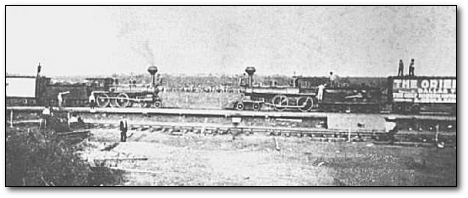The Crash at Crush: A Deliberate Trainwreck
The "Crash at Crush" was a publicity stunt organized by the Missouri-Kansas-Texas Railroad, otherwise known as the "Katy" Line, in 1896. The event was held in Texas area dubbed Crush, created specifically for the event. Ultimately, The Crash at Crush was a reckless, but nonetheless effective, marketing strategy to get people to visit Texas in the late 19th century.
It involved two locomotives being deliberately crashed into each other at full speed in front of a crowd of thousands of spectators. The event was heavily promoted by the railroad as a spectacle, with tickets sold in advance and trains chartered to bring people to the event. However, the crash turned out to be a disaster, as the force of the impact was much greater than expected and several people were killed or injured in the resulting chaos. The "Crash at Crush" is considered one of the most notorious examples of dangerous and irresponsible corporate publicity stunts in American history.
I first heard about this event on Cracked, at all places, and while the event's outcome is certainly no laughing matter, it shows a glimpse into what entertainment constituted before the turn of the 20th century, as the idea garnered thousands of people willing to pay actual money to be witness to a literal trainwreck.
 |
| A photo-op taken before the crash. Cracked really said it best, "What else were you going to do in 1896?" |
The idea for the Crash at Crush was the brainchild of William George Crush, a general passenger agent for the Katy Railroad. Crush came up with the idea as a way to attract attention to the railroad and boost ticket sales. He proposed crashing two steam locomotives together at full speed in front of a crowd of thousands of spectators.
What could possibly go wrong?
The event was heavily promoted in the months leading up to it, with the railroad selling tickets in advance and chartering special trains to bring people to the event. On the day of the event, September 15th, an estimated 40,000 people gathered to watch the crash.
 |
| Here is the location of the event, on our Railroad Points of Interest Map. The Crash at Crush was near present-day West, TX. |
The crash itself was a complete disaster. The force of the impact was much greater than expected, and the locomotives burst into flames and scattered debris everywhere, and the boilers of the steam engines exploded. A test event had occurred in the previous day which hadn't resulted in the explosion, so the railroad assumed it wouldn't happen on the day of the event. While "safety" precautions had been taken, such as having the crowd be 200 yards back from the crash (press had a 100 yard clearance), they were nonetheless ill-prepared for the outcome.
.jpg) |
"Photograph by Jervis C. Deane of two locomotives as their boilers explode during a head-on collision as part of a publicity stunt in 1896 at Crush, Texas, USA. Deane lost an eye from the boilers exploding. The caption reads "The Explosion, Views of the Head End Collision at Crush, Texas, September 15, 1896" (Wikipedia Commons) |
Two were killed and several more were injured in the resulting chaos, and the crowd panicked and tried to flee the scene. The Katy Railroad was heavily criticized for the event, with many people accusing the company of being reckless and irresponsible. The company was also hit with several lawsuits from families of the victims, and William George Crush was forced to resign from his position at the railroad.
The Crash at Crush is considered one of the most notorious examples of dangerous and irresponsible corporate publicity stunts in American history. The event was widely covered in the media of the time, and it was heavily criticized by newspapers, politicians, and the public. The incident resulted in stricter regulations and oversight of railroads and other forms of transportation in the United States.
Sounds reasonable, right? Well, as fate would have it, Crush would rejoin the railroad the following day, and the 30 special excursion trains that the Katy sold to the event more than made up for the negative press coverage. In fact, the Katy line would benefit enormously from the coverage, perhaps being the first example of where any publicity, even negative, was still good publicity on the bottom line.
.jpg) |
| "The moment of impact. Photographer Joe Deane was blinded in one eye by a flying bolt immediately after taking this photograph." (Wikipedia Commons) |
The event is also seen as a symbol of the excess and recklessness of the Gilded Age, the period of rapid economic growth and industrial expansion in the United States in the late 19th century. The Crash at Crush was a reflection of the era's focus on spectacle and entertainment, and it is often cited as an example of the dangers of corporate greed and the need for greater regulation and oversight.
While the actual crash occurred on a side track created specifically for the event, the ensuing damage certainly impacted railroad operations in the area. Despite being used for a staged train crash, the line is still in service to this day as the Fort Worth Subdivision of the Union Pacific Railroad.
Here's a YouTube video on the crash from Train of Thought:
Thanks as always for reading!



Comments
Post a Comment